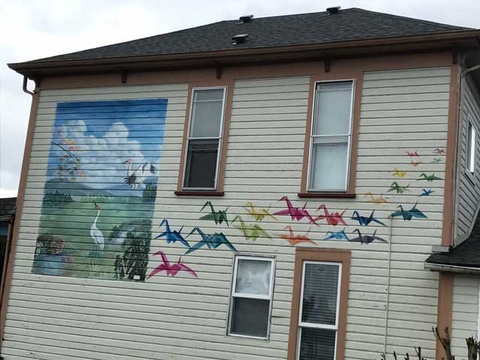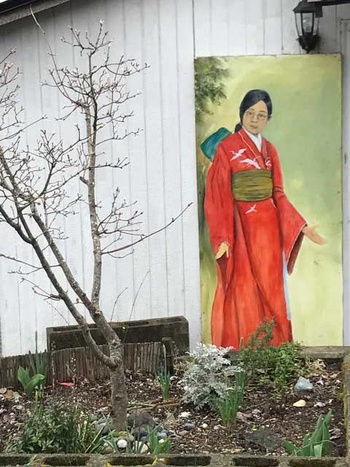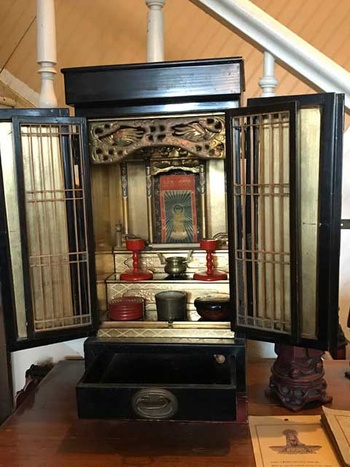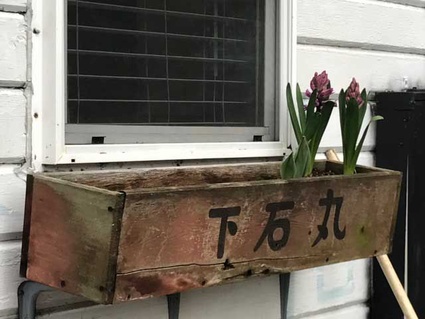Next to a Philly cheesesteak drive-up booth in downtown Tacoma, there’s a wood-frame two-story house, surrounded by vacant lots on either side, facing a desolate parking lot. From the street, even despite the presence of the “peace pole” in the front yard, 1414 Tacoma Avenue doesn’t look like very much. But as luck would have it, I approached “Jean’s House of Prayer” from the back—from the left backyard, in fact—and so I saw Jean right away.
A life-size mural of Jean stands permanently next to the back door of the house. She’s wearing a persimmon colored kimono with white cranes on it. She’s gesturing towards the door, as if welcoming you in.
Until his death in 2015, Jesuit priest and activist Father “Bix” Bichsel lived at Jean’s House of Prayer. His name is well known in peace and social justice circles. Along with Kevin Glackin-Coley, Father Bix established Tacoma’s branch of the Catholic Worker, a community founded to shelter some of the most vulnerable members of the community, folks who are homeless or mentally ill or addicted to drugs. The priest was arrested over forty times for his activism, including actions against nuclear weapons and U.S. military programs.
I had heard that Father Bix named the house “Jean’s House of Prayer” after she left it to him and that he later renamed it “Jean’s House of Peace.” I had heard that Jean was a Japanese American woman who owned the house and left it to Father Bix as a symbol of their friendship and in honor of his work. There was even an altar dedicated to her memory inside the house, some reported.
But how did Jean come to own the house? Through the luck of mutual connections and the generosity of the house’s current inhabitants, I was able to go in.
* * * * *
A sturdy pine tree bisects a view of the front. On either side of the tree branches at the top there are more murals—one of Gandhi, another of Dr. Martin Luther King, Jr. Walking up the front stairs, I could feel that this was a house that asked for my attention.
In the entrance hall, I saw the shrine to Jean right away—a cabinet with black-and-white photos. Several photos of a young Japanese American woman, and a photo of Father Bix himself. On the walls across from the cabinet were more pictures of her and her family. As a young girl, Jean is smiling, wearing glasses and a fancy yellow dress. With some surprise I saw a black lacquer butsudan; not an object you’d expect in the home of a Jesuit priest. Elizabeth Sparks, one of the current residents, opened the butsudan for me, and inside it was beautifully preserved.
Today, Jean’s House of Peace hosts roundtable discussions and events, particularly those related to the peace community. It offers hospitality to members of the community; every year, it is a stop on a peace walk, and the Buddhist monks who stay at the house leave tokens of their appreciation. Upstairs, Father Bix had converted one of the rooms into a prayer and meditation space. There is a stained glass window facing the door—from the outside it would be the center of the front of the house—holds symbols from several world religions. There’s also a statue of the Buddha there.
As I marveled over the shrine to Jean, the door next to the entryway opened and a young woman emerged from a room under the stairs. We introduced ourselves. Nicola, who lived in the house, smiled as she watched me take everything in. “Ah, Jean,” she said. “She’s everywhere.”
* * * * *
Elizabeth, Nicola, and I sat in the living room, a light-filled room with high ceilings and gracious windows. Across from me was Joe Power-Drutis. He knew Jean, and was one of Father Bix's closest friends.
“My most vivid memory of Jean,” he told me, “was of her smile. She just greeted you with this wide smile.” Because she lived next to the Catholic Worker settlement, she used to call on Joe and Bix whenever she needed small things fixed in her house: a light bulb replaced, or changing the smoke alarm battery at the top of the stairs. “She didn’t participate in the church’s activities,” said Joe, “though she was always invited. But she always had this big smile. She still fit right into this community.”
Joe told me that Father Bix’s connections to Japan and Japanese Americans stretched back to his childhood. As a child, Father Bix grew up, in, and around Tacoma’s former Japantown, and had many Japanese American neighbors and playmates. “It was kind of a shock when they were removed,” Joe said. “He felt keenly that they were removed, but he also accepted it as a child of his time.” However, Father Bix had a copy of the infamous wartime “Instructions to persons of Japanese ancestry” poster on the wall of the living room. Though we don’t know many details of his conversations with Jean as his friend, it was clear that he knew that they had a shared history of imprisonment. She decided to leave him the house in the late 1980s, with the understanding that it would be part of the Catholic Worker community settlement.
Father Bix was 18 when the United States bombed Hiroshima, however, and that event marked his consciousness for life. He spent much of his activist life in what Joe called a “community of resistance.” In 2009, he and an interfaith group of Americans traveled to Hiroshima and Nagasaki on a “Journey of Repentance,” seeking to educate themselves about the atomic bombings and to hear the testimonies of hibakusha.
Father Bix was clearly very conscious of the house as a gift from Jean; he had kept many of her books, her photos, and her furniture. “There was this old sofa,” Joe said, laughing, “and it was the most uncomfortable sofa. Nobody wanted to sit on it. But he wouldn’t get rid of it.” “Because it was hers.” I said. He agreed.
Strings of cranes were hung in several places around the house, among the large collection of books occupying much of the living room. The books belonged to Father Bix and some of them, perhaps, to Jean herself. Hearing about Father Bix’s connections to the peace movement, I realized that the cranes were not only a reference to Jean’s Japanese heritage, but a deep gesture of solidarity with the peace movement.
I asked Elizabeth about how it feels to live in a house so steeped in history. “I can definitely feel [Jean’s] presence, and Bix’s,” she says. “It’s a peaceful presence. It reminds me that this work is not just about your life, it’s about something bigger. It guides me in thinking about how I care for and maintain the house.”
Elizabeth had pulled out a photocopied picture from the local newspaper to show me, with Jean as a much older woman. There I found Jean’s last name—Shimoishimaru. She is wide-eyed, praising the volunteers who (according to the caption) were painting her home as part of a citywide initiative called “Paint Tacoma Beautiful.” She has her hands pressed against her cheeks, delighted as a schoolgirl.
* * * * *
Father Bix seemed to take similar delight in the house. I asked Joe to tell me more about the murals. From the back door we walked past Jean’s mural towards a rainbow of origami cranes, the other a landscape with cranes and a maple tree. These murals were the first ones that Father Bix commissioned. They were completed shortly after he inherited the house in 1999 by Jose Mercado. Then we walked in front of the house to look at the murals of Gandhi and Dr. King. We then moved to the other side of the house which is covered in portraits of local Native American leaders, including Chief Leschi and Chief Joseph. What did the murals mean to Father Bix? I asked Joe. He laughed. “Those murals…if he could have put them on his body, he would have. They stood for a history of oppression and resistance. He wanted us to remember the injustice of what had happened here, in the neighborhood.”
* * * * *
Before I left Jean’s House of Prayer, Joe and I stopped for a silent moment in the rain in the garden outside. We paid tribute to Father Bix’s ashes, which are in an urn behind the house. Carved into the nearby cement, gathering moss, I saw many names, including Jean’s. And on the wooden window box at the back, I saw a carved Japanese name. I took a picture and later some friends translated it for me. I had a hunch what the box said, but the translators confirmed it for me: Shimoishimaru, Jean’s last name. Jean was indeed everywhere for those who knew how and where to look.
With the help of my friend Bif Brigman, who has expertise in Nikkei genealogy, I was able to learn even more about Jean. At the public library I found her obituary. She was born Yaeko Jean Sonoda. She grew up in Seattle and had attended Franklin High School. Her high school yearbook picture still has the same glasses that she was wearing as a young woman in her pictures and on the mural. She worked for the Washington Wood and Coal Company during the Depression, and then was incarcerated at Poston and Minidoka during World War II. She married and had two children; her husband Zengoro owned the house on Tacoma Avenue. Members of her family still live in Tacoma.
Because of Jean’s legacy and her friendship with Father Bix, a powerful message of inclusiveness and peace lives on in one of Tacoma’s neighborhoods, just blocks from the center of its former Japantown. Near the house number at the back entrance, I took pictures of the Kanji still visible underneath the latest coat of white paint—four seasons, aki, haru, natsu, fuyu.
© 2017 Tamiko Nimura











